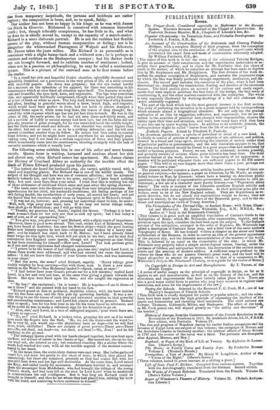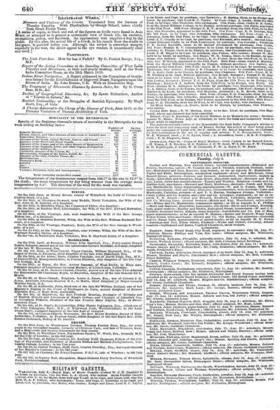PUBLICATIONS RECEIVED.
Bowan
The Prayer-Book, Considered especially in Befereoce to the &Anis!: System. Nineteen Sermons preached in the Chapel of Lincoln's Inn. By Frederick Denison Maurice, ILA., Chaplain of Lincoln's Ina, &c.
Popular Christianity: its Transition State, and Probable Development. By Frederick J. Foxton, A.B., &c.
An Account of the Construction of the Britasmia and Corneal Tubsdrw Bridges; with a complete History of their progress, from the conception of the original idea to the conclusion of the elaborate experiments which determined the exact form and mode of construction ultimately adopted. By William Fairbairn, O.E., &c. [The object of this work is to tell the story of the celebrated Tubular Bridges; to give an account of their construction and the experiments undertaken to as- certain their practicability; and to claim for Mr. Fairbairn that due share of merit in the matter, of which he conceives an attempt has been made to deprive him by Mr. Stephenson and Mr. Hodgkinson. The first division of the work de- scribes the original conception of Stephenson, and narrates the saccessive'stepa by which the idea was finally perfected through experiment, meditation, and dis- cussion. The second part narrates the execution of the plan, when it had been determined on; describing the construction, floating, and erection of the enormous masses. The third section gives an account of the curious and costly experi- ments that were made to ascertain the best form of the bridge, the best mode of constructing it, and the other matters connected with the enterprise. The whole is very copiously illustrated by working-drawings of a full and elaborate . cha- fader, admirably engraved. The part of the book which has the most general in. terest is the first section. The story of perfecting the invention is in a great measure told by correspondence which assumes almost a biographical character. We not only see the graded realization of an idea by suggestion, reflection, and experiment, but we are ad- mitted to the anxieties of practical men charged with responsibility, observe the claims upon their time and attention, and learn how many days work they have to put into one by never wasting hours. In addition to its scientific interest, the correspondence might be called leaves from the life of an engineer.") Esthetic Papers. Edited by Elizabeth P. Peabody.
[An American publication: a species of periodical or serial of a new kind. It is chiefly to consist of articles or essays on subjects of art, criticism, and politics, i
treated in a broad and large spirit, involving the interests of society rather than of particular parties orgovernments; and the sole limitation appears to be, that the views and treatment should be liberal in a good sense—free and unfettered by sordid or factious purposes. Poetry, we see, will be admitted; reviews possibly, and probably reviews of reviews where gross injustice has been done. The most peculiar feature of the work, however, is the irregularity of its appearance: -a number will be published whenever there are sufficient papers to fill 256 octave pages. " This will in no case happen more than three times a year, perhaps not oftener than once a year." The present number contains a dozen articles besides poetry. Some of them are on general subjects,-.-for instance, a.paper on Criticism, by Mr. Ward ; an unpub- lished lecture on War, by Emerson: others have a bearing on American public questions,—as the abuse of representative government, and resistance to civil go- vernment; a few are of.a character more purely literary,—as " Vegetation about Salem." The style or manner of the literature combines English solidity and practical views with traits of German mysticism. In their political principles the writers seem to be of the New England school. They are Republicans as le- gards America, but do not attach any superstitious weight to forms ; they are opposed to slavery, to the aggressive wars of the Democrat party, and to the ex- treme and unscrupulous views of Young America.] The Vicissitudes of the Eternal City; or Ancient Rome: with Notes, Classi- cal and Historical. By James Whiteside, Esq., A.M., M.R.LA., tre4 Author of " Italy in the Nineteenth Century." [This volume is in great part an amplified translation of Canina's Guide to the Antiquities of Rome; which Mr. Whiteside' after examination, inquiry, and ex- ploration upon the spot, considers the best book upon the subject. To the Italian's account of the antiquities, arranged in the order of Regiones, Mr. Whiteside has added a description of Canine's large map, and a brief view of the same author's Topography of Rome. He has himself written a chapter on the street and house architecture of the Romans, in order to convey an idea of the general appearance of the ancient city, and the domestic accommodation of the masters of the world. This is followed by an essay on the vicissitudes of the city; in which Mr. Whiteside very properly takes a simple archieological course, tracing, under the guidance of Gibbon, and antiquarian writers, the destruction of the ancient monu- ments and the erection of modern edifices. A sufficient map is prefixed to the volume for those who do not possess Canine's great work; and the book will be found altogether to answer its purpose, which is that of a companion to Mr. Whiteside's Italy in the Nineteenth Century, or as &guide for the visiter of Borne.] On Copyright in Design in Art and Manufactures. By T. Turner, of the
Middle Temple.
[A series of useful essays on the principle of copyright in design, so far as it applies to art and manufactures, as well as on the history of the law, and the alterations and improvements that have latterly taken place in it. There are also a good many useful hints to parties who may have occasion to register their inventions, and some for the improvement of the law.] Poetry for Schools. Selected by the Reverend F. C. Cook, MA, one of her Majesty's Inspectors of Church Schools. [This little book is chiefly designed for public or popular schools; and the selec- tions have been made upon the high principle of expanding the intellect of the pupils and humanizing and elevating their sentiments. The chief authors are Cowper, Thomson, Goldsmith, Milton, and Shakspere. The effect of the book, as Mr. Cook points out, will depend greatly on " the ability and discretion" of the teacher.] History of Europe, fromthe Commencement of the French Revolution dottre Restoration of the Bourbons in 1815. By Archibald Alison, LL.D., F.RS.11. New edition, with Portraits. Volume IV.
[The rise and progress of Napoleon during his earlier Italian campaigns and his invasion of Egypt form one subject of this volume; the campaign of Moreau and the Archduke Charles in Germany another; the internal affairs of Great Britain in 1797 and the events of the naval war a third. The portraits are Bonaparte after Appiaui, Moreau, and Key.]
Raphael; or Pages of the Book of Life at Twenty. By Alphonse de Lamar- tine. (Slaters Series.) The Home; or Family Cares and Family Joys. By Frederika Bremer Volume I (Bremer's Novels.) Evangeline; a Tale of Acadie. By Henry W. Longfellow, Author of Alta " Voices of the Night." (Slater's Series.) [Three volumes, bound in green canvass, at a shilling a piece.] Life. of Jean Paul F. Richter. Compiled from various sources. Together with his Autobiography, translated from the German. Second edition. The Works of Francis Rabelais. Translated from the French. Volume IL
(Bohn's Extra Volume.) Roger of Wendover's Flowers of History. Volume II. (Bohr& Antiqua- rian Library.)
buffer th Manners and Customs of the Gieek.s.- Translated from the German of Theodor Panofka. With Illustrations byuGe9igt1S6harf, taken chiefly fi em Meek Pictile Vanes. LA.,seties of copies, in black and red, of theSgares fin.fictlie vases found in Asia. Minor, so arranged as to present a systematic view of Greek life, lite customs, lions, games, and hmideutp., An :explanatory teat. supplies xi key to the . By this plan, the actual lire of a.Greek, In his march from the cradle to est gave, le paraded before you. Although the review is somewhat meagre, pilly in the teat, the dB' ect appeal to the eye renders it uticonimonly cleir and-vivid.] .
PAMPHLETS.
The Irish Poor-law. lloW far has it Failed ? By G, Pottlett Scrope, Esq., M.P. t tithe Acting Committee to the Standing-Committee of West India/ lanters'and Merchants, at their halt-yearly meeting, held at the West. Andittitoinmittee Room, on the 28th Ettirch 1849.
''indicirt /fiver Navigation. A RePort addressed to the Committee of Gentle-
men formed for the Estahli.shrnent of Improved Steam NSvjgationupon the
Rivers-of, India. By John Bourne, C.E. With-an Illustrative Map.
The TriatMent of Rheumatic DiSeases by .Lemon Juice; &c. By G. Owen . Rees,41.12., &c. -- • : Decline of GeOgraphical Discovery, &c.: By .ramts Richardson, Author of "Travels in Saharap &e. - 4 Scottish Nationality; or the Strtiggles 'of-Sceteish 'Episcopacy, By Thigh Scott, Esq., of Gala. A Charge delivered to the Clergy of the Diocese cif York, June 1819, at the Primary Visitation of Thomas Archbishop of York.

























 Previous page
Previous page